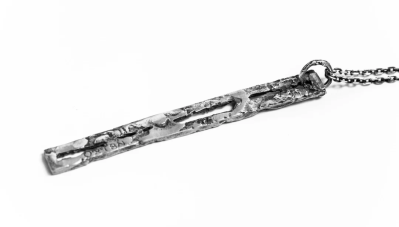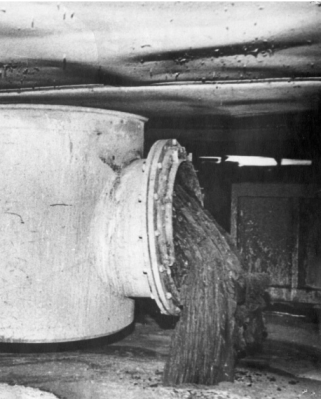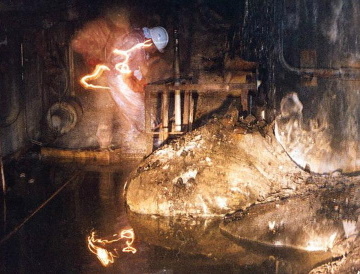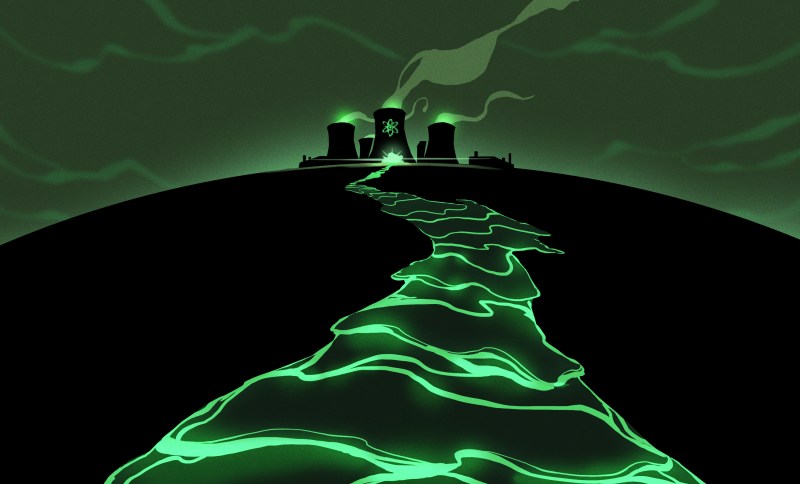So now we’ve talked about all kinds of byproducts, including man-made (Fordite), nature-made (fulgurites), and one that’s a little of both (calthemites). Each of these is beautiful in its own way, but I’m not sure about the beauty and merit of corium — that which is created in a nuclear reactor core during a meltdown.

Corium has the consistency of lava and is made up of many things, including nuclear fuel, the products of fission, control rods, any structural parts of the reactor that were affected, and products of those parts’ reaction with the surrounding air, water, and steam.
If the reactor vessel itself is breached, corium can include molten concrete from the floor underneath. That said, if corium is hot enough, it can melt any concrete it comes in contact with.
So, I had to ask, is there corium jewelry? Not quite. Corium is dangerous and hard to come by. But that doesn’t stop artisans from imitating the substance with other materials.
Forming Corium

Corium lava was produced at both Chernobyl and Fukushima Dai’ichi, and on a smaller scale at Three Mile Island. It’s a rare thing, this man-made lava, and it’s only produced when humans gather enough highly-radioactive isotopes to start a chain reaction.
When a nuclear meltdown occurs, the fission reaction occurring within the reactor is no longer sufficiently cooled and contained to keep the rods, cases, core containment vessel, et cetera cool. Heat builds rapidly, produced by the fission of uranium-235 and plutonium-239.
If the chain reaction of fission and decays is allowed to go on, the heat will build up enough that the fuel rods start to bend and eventually melt. Usually, this is controlled by cooling water and control rods that are able to absorb some of the neutrons created by fission and decay. But if the fuel rods become fully molten, then you’ve got a meltdown on your hands.
April 26, 1986
The largest formation of corium in existence occurred during the Chernobyl disaster. In fact, so much corium issued forth that the molten mass dripped underneath to form stalactites, stalagmites, and lava flows such as the Elephant’s Foot.

Chernobyl’s corium was formed over several days in three phases, the first of which lasted only seconds. The second stage lasted six days and comprised the interaction of the lava with silica-based structural materials like sand, concrete, and serpentinite. Finally, fuel lamination took place, and the molten corium penetrated the floors and solidified.
The corium at Chernobyl consists of uranium dioxide fuel, zircaloy cladding, concrete, and the serpentinite that had been packed around the reactor to serve as thermal insulation. Analysis has since shown that the corium reached a maximum temperature of 2,255 °C (4,091 °F). Far from cooling quickly, it remained above 1,660 °C (3,020 °F) for several days.
Chernobyl Corium
There are five types of material in Chernobyl’s corium:
- black ceramics: dark black, glassy material with a highly pitted surface
- brown ceramics: brown, glassy material that is both glossy and dull
- slag-like granulated corium: these are glassy granules with a crust and range from gray-magenta to a dark brown. These were formed by extended contact of brown ceramics with water
- pumice: grayish-brown porous formations that were formed when molten brown ceramic came into contact with water
- metal: both molten and solidified
The Elephant’s Foot is a large mass comprised of black corium and has many layers. It resembles tree bark on its surface. In order to get to where it was discovered in December 1986 (15 meters southeast of the reactor in a maintenance corridor), the corium burned through 2 m (6 ft) of reinforced concrete, then traveled through pipes and fissures and flowed down a hallway.
Three Mile Island
By comparison, the accident at Three Mile Island was a slow, partial meltdown. Within two minutes, over 40,000 pounds of various materials melted and relocated. And although a pool of corium formed at the bottom of the reactor vessel, it wasn’t breached.
Eventually, scientists took samples from the reactor and discovered two masses of dull, grey corium with a few yellow areas — one in the fuel assembly, and the other on the lower head of the reactor vessel. They found the corium to be mostly molten fuel and cladding. Elementally, it was mostly uranium, along with zirconium, oxygen, stainless steel, and an alloy called Inconel. Some of the samples included silver and indium from the control rods.
Melting and Smelting
Man-made lava is a terrible, amazing thing that, ideally, will remain rare. But not all byproducts are rare, and certainly not all of them have cool names. What could I possibly be talking about? Stay tuned!















“man made lava” is not very remarkable. Plenty of slag waste from the steel manufacturing industry. Anything melts and even evaporates, and then turns into a plasma if you make it hot enough.
https://www.youtube.com/watch?v=Fq9AC5lo31A
Pity asbestos doesn’t fit the category.
Presumably you meant something more metaphorical, but turning asbestos into “man-made lava” is fairly straightforward and also an effective (if not necessarily practical) way to render it harmless.
Fundamentally, asbestos is just a silicate mineral, and despite its insulating qualities, it melts at around 1250 Celsius, a temperature that humanity has been able to create since the iron age.
Thoroughly melting the stuff will convert it from dangerous fibers into inert slag (or through a slightly fancier, more controlled process, it can even be converted into silicate glass).
(also, along with the slag that [paulvdh] mentions above, molten glass is surely the other most common type of man-made lava.)
Forge a sword out of it. We need to be making enchanted and cursed artifacts
A sword that slowly and silently kills the wielder with radiation? Yup, that’s pretty cursed all right!
Yeah, exactly. Awesome.
You can gift it to your enemy.
Not sure if it would be slowly!
Corium? Isn’t that the stuff they make countertops out of? Wait, that’s Corian. Why did they bother to give it a fancy name if it only happens when a reactor lets out the magic smoke? Ideally, that doesn’t happen very often. (It happened three times! Let’s name it!) It’s slag. That stuff’s been made more than three times – which is why it has a name.
Maybe rename it “meltdownium”.
No, it’s Chinesium, as it was supposed to be the stuff that melts a hole all the way to China.
IIRC, a PBS special (during the 1990s?) on Chernobyl called lava/slag of “the Elephants Foot” something like “Chernobite”.
I remember it being Chernobylite
I won’t argue that!
There was a story in the news about somebody who bought countertops containing dangerous levels of uranium. They weren’t artificial, just a natural deposits and nobody realized they were there. I mean, do you check your countertops with a Geiger counter?
Wait, this one is Hackaday. There’s probably several people reading this who check everything in the house with a Geiger counter because what else will you do after you built one?
…I feel attacked.
On an unrelated note. I know a U.S. Coast Guard boarding team member who hair their PRD (personal radiation detector) max out while boarding a Japanese fishing boat. Turns out several major engine components, or pieces engine room equipment were made from metal salvaged from far too close Fukushima incident.
Thought it was a sea story until I read an article about construction workers illegally salvaging steel from the area. So, maybe we should be carrying around Geiger counters?
The statement that the “fission reaction is no longer sufficiently cooled” resulting in reactor meltdown and production of corium is incorrect. For all the accidents cited the meltdowns occurred due to inability to remove heat generated from radioactive decay of fission products produced during reactor operation. TMI and Fukusima Daiichi were both fully shutdown prior to core meltdown. At Chernobyl the reactivity accident and power excursion caused an explosion that severely damaged the core, but was not the main cause of meltdown.
No longer sufficiently cooled and inability to remove heat are equivalent in my book